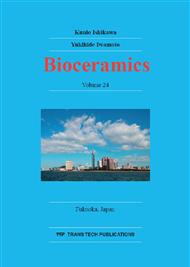p.351
p.357
p.361
p.365
p.370
p.374
p.379
p.385
p.391
Analysis of Gene Expression and Morphology of P19 Cells Cultured in an Apatite-Fiber Scaffold
Abstract:
Heart disease is the second most common cause of mortality in Japan. Most cases of late stage heart failure can only be effectively treated by a heart transplant. Cardiac tissue engineering is emerging both as a new approach for improving the treatment of heart failure and for developing new cardiac drugs. Apatite-fiber scaffold (AFS) was originally designed as a substitute material for bone. AFS contains two sizes of pores and is appropriate for the three dimensional proliferation and differentiation of osteoblasts. To establish engineered heart tissue, a pluripotent embryonal carcinoma cell line, P19.CL6, was cultured in AFS. P19.CL6 cells seeded into AFS proliferated well. Generally, cardiac differentiation of P19.CL6 cells is induced by treating suspension-cultured cells with dimethyl sulfoxide (DMSO), after which the cells form spheroids. However, our results showed that P19.CL6 cells cultured in AFS differentiated into myocytes without forming spheroidal aggregates, and could be cultured for at least one month. Thus, we conclude that AFS is a good candidate as a scaffold for cardiac tissue engineering.
Info:
Periodical:
Pages:
370-373
Citation:
Online since:
November 2012
Authors:
Price:
Сopyright:
© 2013 Trans Tech Publications Ltd. All Rights Reserved
Share:
Citation:


